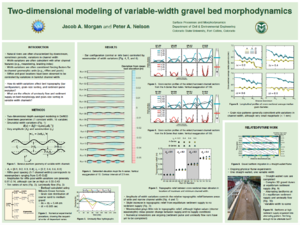Annualmeeting:2017 CSDMS meeting-011: Difference between revisions
Created page with "{{CSDMS meeting personal information template-2014 |CSDMS meeting first name=Jacob |CSDMS meeting last name=Morgan |CSDMS meeting institute=Colorado State University |CSDMS me..." |
No edit summary |
||
| Line 42: | Line 42: | ||
{{CSDMS meeting abstract template | {{CSDMS meeting abstract template | ||
|CSDMS meeting abstract=Rivers in natural settings are frequently characterized by downstream variations in channel width. However, the effect of width variations on bed topography and sorting patterns remains poorly understood, especially under conditions of changing sediment and hydrologic regimes. In this study we use two-dimensional numerical modeling to systematically explore how the amplitude and wavelength of sinusoidal width variations affect the shape and location of bars, sorting patterns of surface sediment, and the movement of a sediment pulse. We perform simulations with sediment regimes consisting of constant sediment supply, no sediment supply, and a sediment pulse with no background sediment supply. We also perform steady and unsteady flow simulations to explore the combined effect of hydrograph shape and width variations. Preliminary results indicate that width variations force riffle-pool topography with riffles coincident with wider channel sections and pools at narrow sections. The amplitude of width variations is the dominate factor controlling riffle-pool relief. The wavelength of the width variations controls whether central or side bars develop in the wider channel sections. These numerical simulations are complimented with ongoing physical experiments in a laboratory flume and can potentially be used to guide stream restoration and river management practices under conditions of varying sediment and hydrologic regimes. | |CSDMS meeting abstract=Rivers in natural settings are frequently characterized by downstream variations in channel width. However, the effect of width variations on bed topography and sorting patterns remains poorly understood, especially under conditions of changing sediment and hydrologic regimes. In this study we use two-dimensional numerical modeling to systematically explore how the amplitude and wavelength of sinusoidal width variations affect the shape and location of bars, sorting patterns of surface sediment, and the movement of a sediment pulse. We perform simulations with sediment regimes consisting of constant sediment supply, no sediment supply, and a sediment pulse with no background sediment supply. We also perform steady and unsteady flow simulations to explore the combined effect of hydrograph shape and width variations. Preliminary results indicate that width variations force riffle-pool topography with riffles coincident with wider channel sections and pools at narrow sections. The amplitude of width variations is the dominate factor controlling riffle-pool relief. The wavelength of the width variations controls whether central or side bars develop in the wider channel sections. These numerical simulations are complimented with ongoing physical experiments in a laboratory flume and can potentially be used to guide stream restoration and river management practices under conditions of varying sediment and hydrologic regimes. | ||
|CSDMS meeting posterPDF=jam_csdms_20170522_2.pdf | |||
|CSDMS meeting posterPNG=jam_csdms_20170522_2.png | |||
}} | }} | ||
{{blank line template}} | {{blank line template}} | ||
Latest revision as of 07:25, 6 June 2017
Browse abstracts
Two-dimensional modeling of variable-width gravel bed morphodynamics

Rivers in natural settings are frequently characterized by downstream variations in channel width. However, the effect of width variations on bed topography and sorting patterns remains poorly understood, especially under conditions of changing sediment and hydrologic regimes. In this study we use two-dimensional numerical modeling to systematically explore how the amplitude and wavelength of sinusoidal width variations affect the shape and location of bars, sorting patterns of surface sediment, and the movement of a sediment pulse. We perform simulations with sediment regimes consisting of constant sediment supply, no sediment supply, and a sediment pulse with no background sediment supply. We also perform steady and unsteady flow simulations to explore the combined effect of hydrograph shape and width variations. Preliminary results indicate that width variations force riffle-pool topography with riffles coincident with wider channel sections and pools at narrow sections. The amplitude of width variations is the dominate factor controlling riffle-pool relief. The wavelength of the width variations controls whether central or side bars develop in the wider channel sections. These numerical simulations are complimented with ongoing physical experiments in a laboratory flume and can potentially be used to guide stream restoration and river management practices under conditions of varying sediment and hydrologic regimes.
